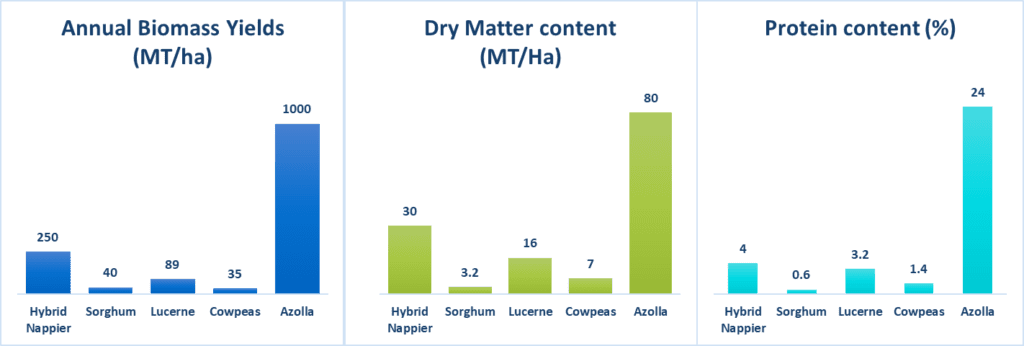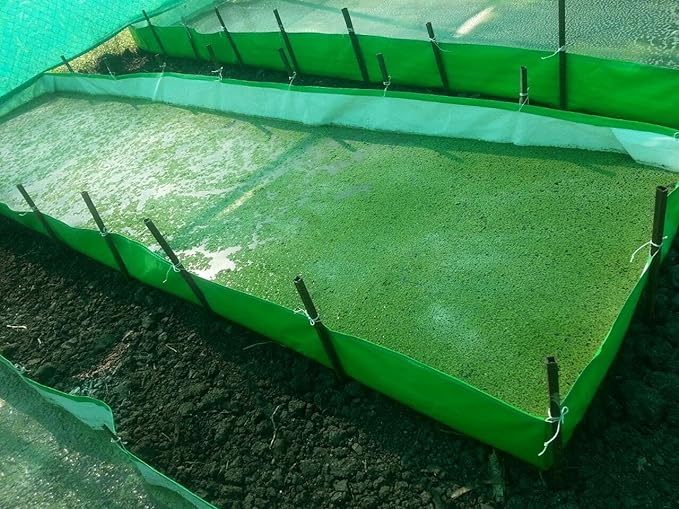Are you wondering how to grow azolla in Kenya? For centuries, the Azolla has been used as a natural fertilizer and livestock feed. It is commonly found in freshwater environments such as ponds, lakes, and rivers. Given its its high demand, azolla farming in Kenya is one of the fastest high-value farming ventures.
Table of contents- Jump to Section
Facts about Azolla

Also known as mosquito fern, duckweed fern, fairy moss, or water fern, azolla is an aquatic fern that is rich in nutrients and can be used as a feed supplement for livestock giving you more yields and profits. It is a branched, free-floating aquatic fern with a rapid growth rate.
The Azolla plant has 3 varieties or species that you can grow in Kenya. These are,
- Azolla Nilotica
- Azolla Imbricata
- Azolla Pinatta.
The most common variety that is grown in Kenya is Azolla Pinatta.
Related: Is Spirulina Farming in Kenya Really Profitable?
Azolla can double its biomass within 2-3 days, it requires minimal input costs, and is in high demand among farmers. This post will educate you on Azolla farming in Kenya.
- Azolla is a fast-growing aquatic plant that can double its biomass within 2-3 days under ideal conditions.
- Azolla protein content is 25-30% protein, which is higher than most other conventional animal feed sources such as maize, wheat, and soybean as shown above.
- Azolla is rich in essential amino acids, vitamins, and minerals, making it a complete feed for livestock.
Uses of Azolla
Azolla farming has gained high popularity among Kenyan farmers due to its many benefits for farmers and the environment. Azolla has a fast growth rate, high nutrient content, and low production cost. In addition, it is rich in nitrogen. Due to these benefits, it has been known to increase crop yields when used as a natural fertilizer. Additionally, Azolla can be used as a cheap, protein-rich feed for livestock such as poultry, goats, and cattle.
Azolla farming is also a sustainable and eco-friendly practice. Azolla fixes nitrogen from the air and converts it into a form that can be easily absorbed by plants. This makes it an excellent organic fertilizer that can improve soil fertility and reduce the need for chemical fertilizers. Furthermore, Azolla is a non-toxic and non-invasive plant that does not pose any harm to the environment.
Benefits of Azolla farming

Why should you consider growing Azolla? Below is a summary of the top benefits of Azolla farming that you can get;
- Low production cost: Azolla farming requires minimal input costs. The only significant cost involved is the initial setup cost of the pond or tank, which is relatively low
- High yields: Azolla can double its biomass within 2-3 days under ideal conditions. You can harvest the crop every 5-7 days, providing a continuous supply of feed for your livestock.
- High market demand: The demand for Azolla seeds and plants is increasing in Kenya. It is high among organic farmers who are looking for cheap organic livestock feed and organic fertilizers.
- Multiple uses: Azolla can also be used as a natural fertilizer, a biofuel, and a source of bioactive compounds for the pharmaceutical industry.
- Mosquito control; Azolla restricts the mosquito breeding process. It prevents the survival of larvae and hinders the laying of eggs on the surface.
- Weed control; Azolla is a perfect companion plant for organic paddy rice farmers. It works by nitrogen fixation, blocking sunlight, and works as mulch that prevents water loss and hinders weed growth.
Where to grow Azolla in Kenya
Are you wondering if your place is fit for Azolla farming? You can grow Azolla in ponds, ditches, or wetlands. You are good to go if you have a source of stagnant or slow-moving water. The best ecological conditions for growing Azolla are;
- Access to freshwater
- Soils with pH of 3.5-10. The Optimum growth is observed at pH 4.3-7.
- Temperature ranges of between 20-30°c.
- An area with full or partial shade, with about 25-50% access to sunlight daily.
- A supply of composted manure.
- Available space, for the purposes of holding manure.
How to grow Azolla in Kenya
As shown above, Azolla farming gives you an opportunity to improve your farm’s profits and yields. Below we give you six steps on how to start and manage an Azolla farm: these include location selection, pond making, and harvesting.
1. Choose the Right Location
Selecting the ideal location for your Azolla farm is crucial for its success. Azolla thrives in areas that receive partial sunlight, ideally between 25% to 50% exposure. This balance helps prevent excessive evaporation while still promoting photosynthesis, which is essential for growth.Additionally, access to a reliable water source is vital. Azolla grows best in shallow water bodies, so ensure that your chosen site can maintain consistent water levels. The water’s pH is another important factor; aim for a range between 4.3 and 7.5 for optimal growth conditions.
2. Set Up the Pond or Tank
The next step involves constructing a suitable pond or tank for your Azolla culture. Choose materials that are UV-resistant, such as high-density polyethylene (HDPE) or plastic liners, to minimize degradation from sunlight and ensure longevity.The dimensions of your pond should be carefully considered. A depth of at least 50 cm is recommended, along with a minimum surface area of 10 square meters. For those aiming for higher production, a larger pond will yield more biomass. For instance, dimensions of approximately 2m (L) x 1.5m (W) x 0.15m (D) can support daily production of about 1 kg of Azolla.Incorporate a drainage system to prevent waterlogging, which can lead to anaerobic conditions detrimental to Azolla health.
3. Prepare the Azolla Culture
To establish your Azolla farm, you’ll need an initial culture of the fern. Approximately 500g of Azolla culture per square meter is required to start your pond effectively. You can obtain this culture from reputable suppliers or collect it from natural sources like ponds or wetlands.Once you have your culture, it’s essential to acclimatize it to its new environment before introduction. Place the Azolla in a shaded container filled with water for 2-3 days. This step allows the plants to adjust gradually and reduces transplant shock.
4. Introduce Azolla to the Pond
After acclimatization, it’s time to introduce the Azolla to your pond or tank. Spread the culture evenly across the surface of the water, aiming for an initial density of around 100-200 grams per square meter. This careful distribution ensures that each plant has enough space and resources to thrive.
5. Maintenance and Nutrient Management
Once established, maintaining optimal growth conditions is key to successful Azolla farming. Regular monitoring of water quality is essential; keep the water fresh and free from pollutants while maintaining temperatures between 20°C and 30°C.To support vigorous growth, nutrient management plays a critical role. Every five days, add a mixture of 20g of super phosphate and about 1kg of cow dung to the pond. This nutrient boost helps sustain healthy biomass production and enhances the nutritional value of the Azolla as livestock feed.
The pH should be maintained between 6.5 and 7.5, and the water should be changed every 7-10 days. Remove any litter or aquatic weeds seen in the pond regularly.
6. Harvesting
Harvesting is an exciting phase in Azolla farming and should begin when the plants cover about 80% of the pond’s surface, typically around 15 days after planting. Use a fine net or scoop to collect the Azolla carefully, ensuring that some remains in the pond for continued growth. Regular harvesting every 3 days is recommended to prevent overcrowding and maintain optimal biomass levels. The harvested Azolla can be used as livestock feed or as an organic fertilizer for crops.
Harvested Azolla is to be washed thoroughly to remove dirt and the smell of cow dung before feeding them to animals. The harvested Azolla should be dried in the sun for 1-2 days to reduce its moisture content. The dried Azolla can be sold to livestock farmers or used as a natural fertilizer. The price of a kilogram of Azolla goes to Ksh 1000.
Conclusion
Azolla farming in Kenya is an easy way to improve your yields and profits. You can use Azolla as an organic fertilizer and livestock feed. Other benefits include reduced costs, increased crop yields, and improved animal health. By following the guidelines and tips outlined in this article, farmers can successfully start and manage an Azolla farm for maximum profitability and sustainability.
FAQs on Azolla Farming in Kenya
1. How much are azolla seeds per kg in Kenya?
Azolla seeds are priced at approximately KSh 1,000 per kg in various markets across Kenya, although some suppliers offer them for as low as KSh 500 per kg.
2. How fast does azolla multiply?
Azolla is known for its rapid growth, capable of doubling its biomass every 3 to 5 days under ideal conditions.
3. Can azolla survive without sunlight?
No, azolla cannot survive without sunlight. It requires light for photosynthesis, and prolonged absence can lead to its decline in yields and vitality.
4. How can I make my azolla grow faster?
To promote faster growth, ensure that azolla receives partial shade, maintain high humidity (around 80-90%), and provide nutrients like cow dung or super phosphate fertilizer regularly.
5. Why is my azolla turning black?
Azolla may turn black due to several factors including excessive sunlight exposure, high temperatures, nutrient deficiency, or fungal/bacterial infections. Initially, it may turn brown before progressing to black.
6. How to plant azolla seeds in Kenya?
To plant azolla seeds:
- Maintain a shaded environment to prevent overheating.
- Prepare shallow ponds (10-12 cm deep).
- Fertilize the water with cow dung slurry.
- Introduce the seeds into the nutrient-rich water.
7. What is the disadvantage of azolla?
The main disadvantages include its potential to shade out other aquatic plants, leading to reduced biodiversity and possible negative effects on fish populations due to decay odors.
8. Is azolla farming profitable in Kenya?
Yes, azolla farming is considered profitable, particularly for livestock farmers looking to reduce feed costs significantly. It serves as a nutritious feed alternative and can also be sold as a product
Additional Reading Resources
Did you Like the Post? Let us know below
Agcenture.com is your best agriculture, food & health blog.
Thank you for following us on Facebook, Twitter (X), LinkedIn, YouTube, and WhatsApp @ Agcenture for the latest updates.

Can you connect me to someone who can do Azola in my farm?